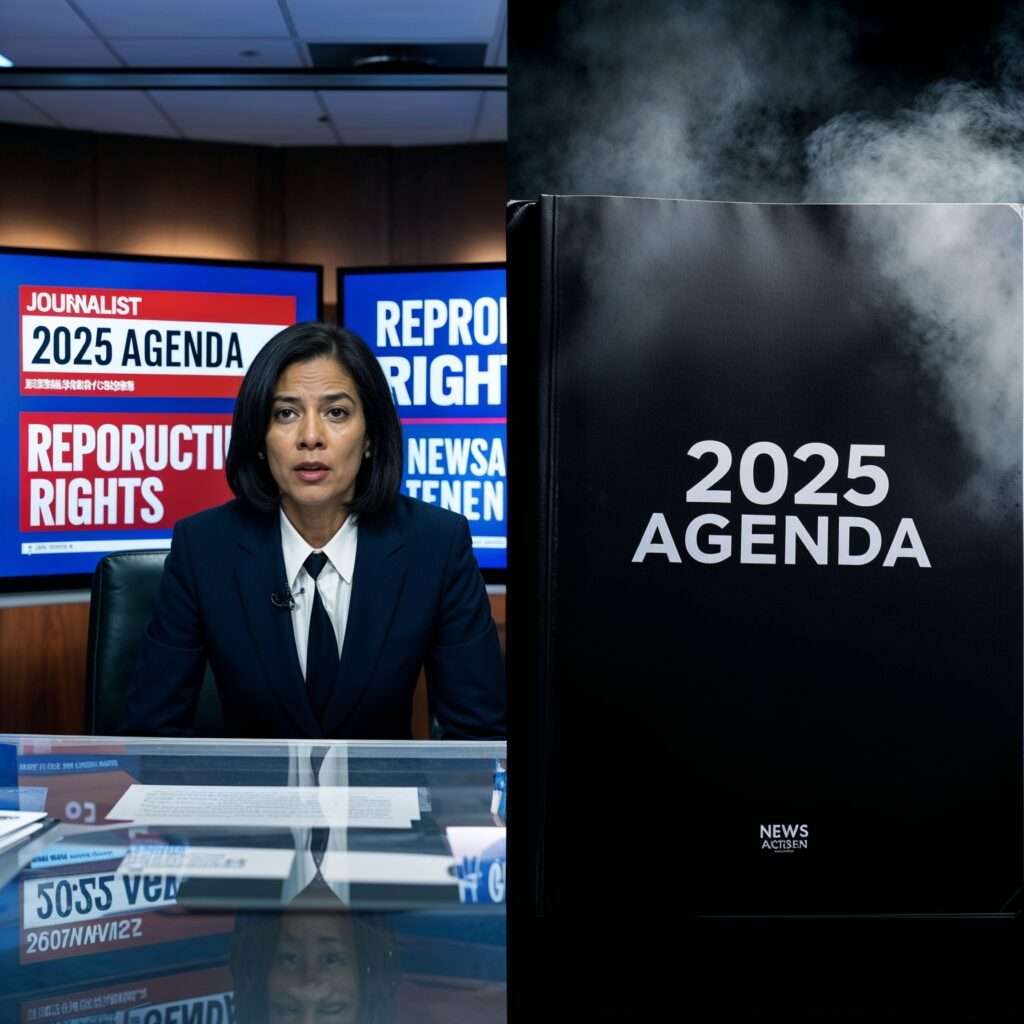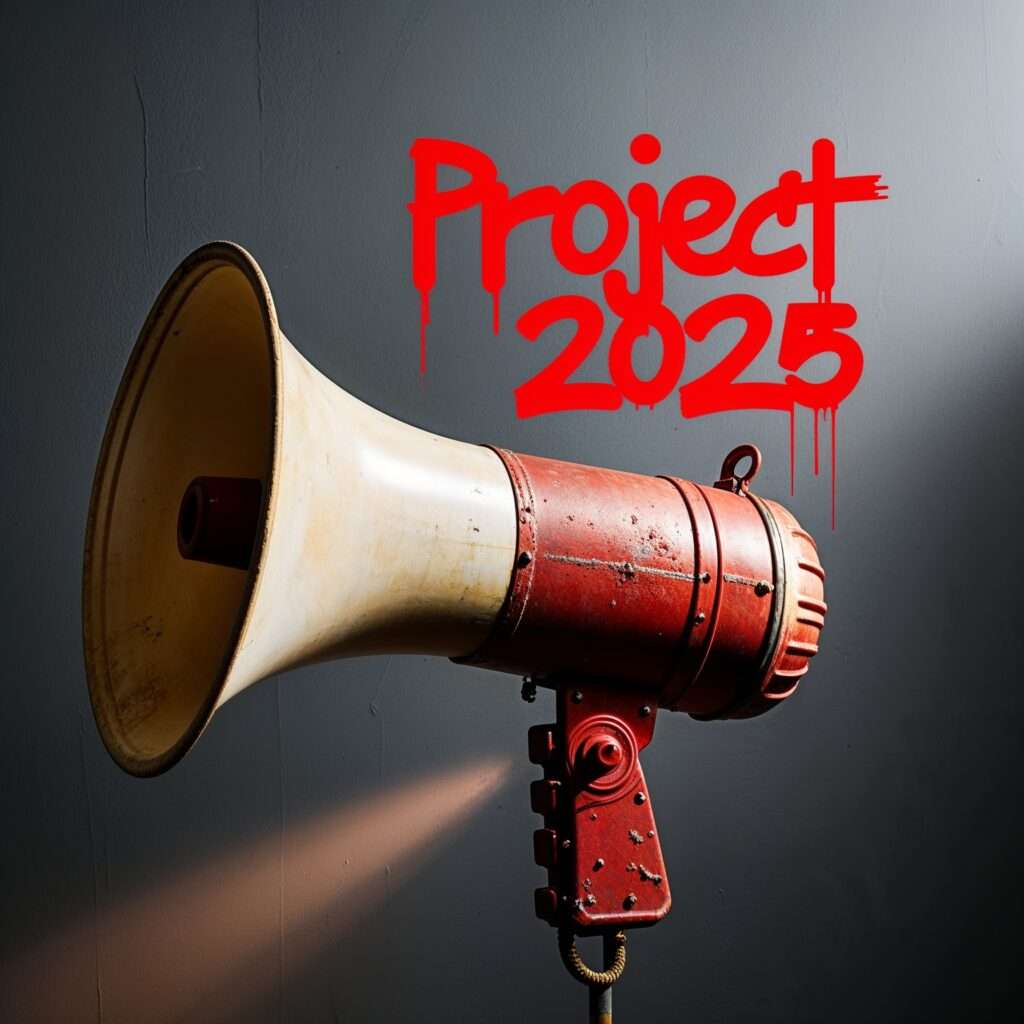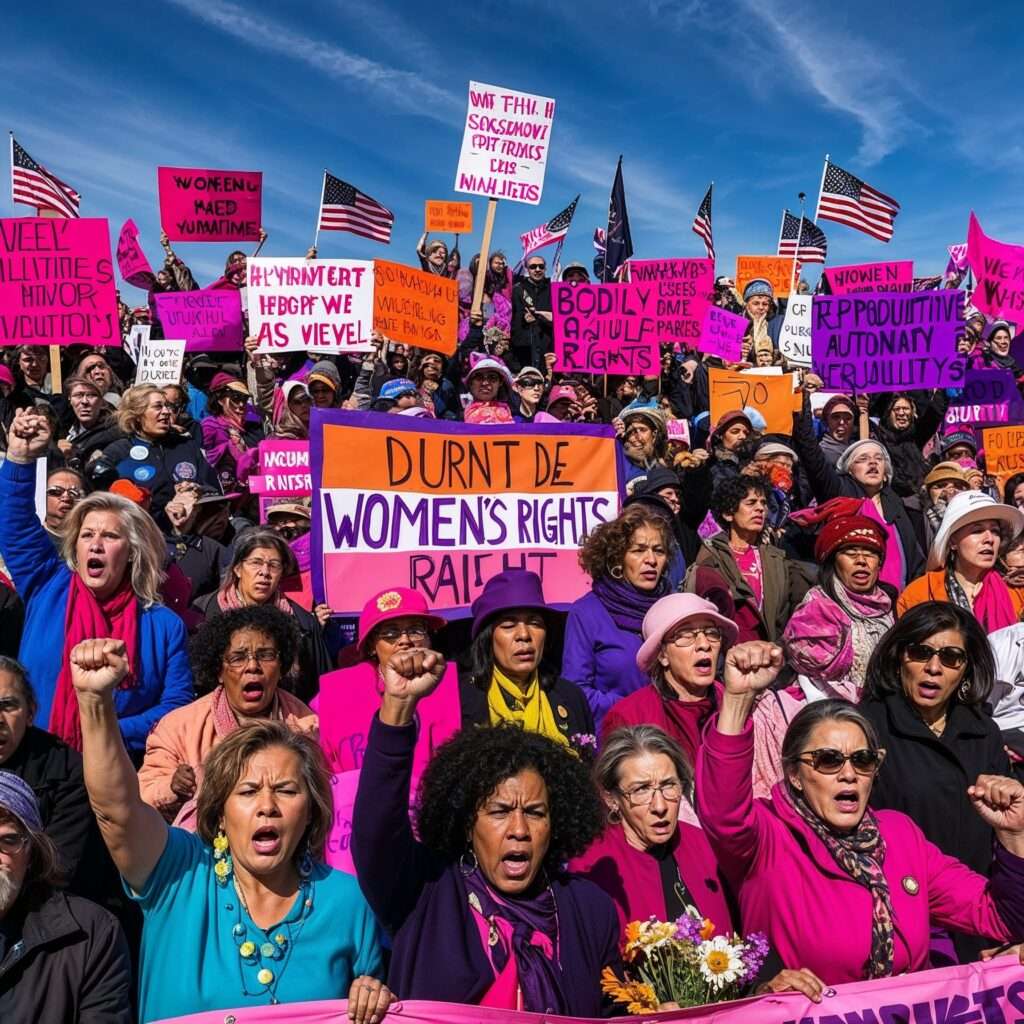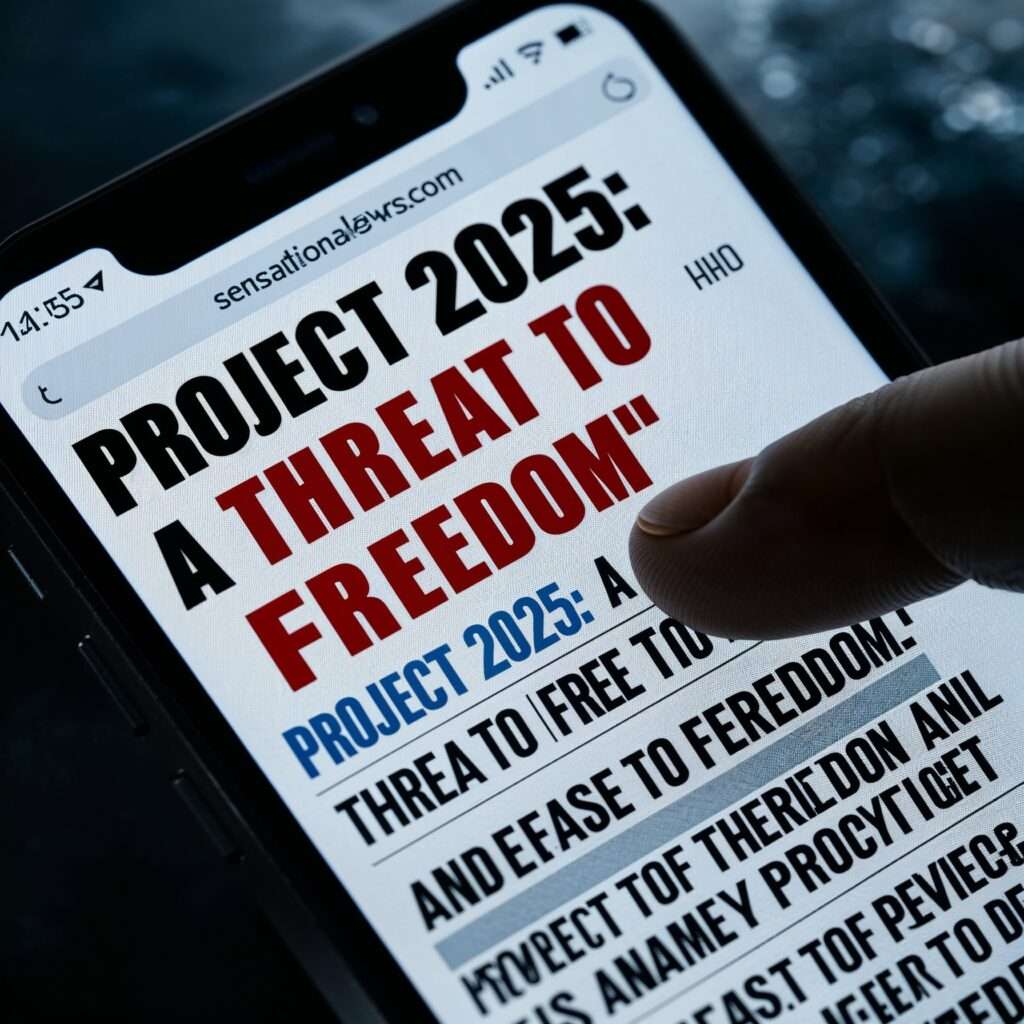
A split-screen image of a journalist discussing reproductive rights tied to the 2025 agenda, alongside a symbolic black book titled “2025 Agenda.”
The media focus on Project 2025 has increasingly dominated political discourse, painting a vivid picture of looming threats to reproductive rights and other social freedoms. With the 2024 presidential election in full swing, this narrative has gained prominence, even though Project 2025 remains largely speculative and not officially tied to Donald Trump or the Republican Party.
Despite its uncertain origins, the media focus on Project 2025 has turned into a rallying cry for progressives and a source of division in public opinion. This article examines the origins of Project 2025, its association with Trump, and the media’s selective focus on reproductive rights as a driving narrative.
The Origins of Project 2025
Project 2025 first surfaced through conservative think tank initiatives, particularly from the Heritage Foundation, which introduced it as a policy framework for a potential Republican presidency post-2024. The proposals aim to overhaul federal institutions, dismantle progressive policies, and reinforce conservative values in areas such as education, healthcare, and reproductive rights.
While Project 2025 reflects the policy priorities of certain ideological circles, it is not an officially endorsed Republican platform, nor has Donald Trump explicitly embraced it. However, media narratives have amplified its significance, framing it as a concrete plan closely tied to Trump’s political philosophy.
This association has been bolstered by Trump’s judicial appointments, particularly the Supreme Court justices instrumental in overturning Roe v. Wade. This decision returned the regulation of abortion to the states, allowing for more local control—a reality far from the sweeping federal measures the media often suggests.
Trump, Abortion, and the Media’s Fixation
Although Trump has not formally adopted Project 2025, his affiliation with its goals stems from his history of advancing conservative policies. The Dobbs v. Jackson Women’s Health Organization decision, made possible by his appointees, overturned Roe v. Wade, reigniting debates over reproductive rights and cementing Trump’s role as a key figure in the conservative movement.
Media focus on Project 2025 is used as connecting a potential roadmap for a Trump-led rollback of reproductive freedoms to help drive fear. This framing often exaggerates the scope of Project 2025 while ignoring key facts, such as that most abortions are not performed for medical necessity. The omission of this context distorts the moral debate, allowing fear-driven narratives to dominate.
This focus on reproductive rights as a central issue not only skews public perception but also redefines moral principles. Protecting unborn life—a value rooted in biblical teachings—is reduced to a partisan agenda, despite its deeper ethical implications. Trump’s actions align with pro-life values, but there is little evidence to suggest he intends to push extreme federal measures under a second term.
The Media’s Role in Amplifying Project 2025
The portrayal of Project 2025 has transformed it from a policy framework into a perceived imminent threat. By consistently tying it to contentious social issues, the media has elevated its significance in public discourse.
Constructing a Conservative Threat
Media focus on Project 2025 portrays it as a calculated effort to reverse decades of social progress, particularly in areas like abortion access. This framing positions the initiative as more than a policy proposal—it becomes a symbol of a broader conservative agenda to undermine personal freedoms.
This narrative is misleading. While Project 2025 does propose conservative reforms, these are not tantamount to the federal restrictions the media suggests. The framing serves more to mobilize opposition than to present a balanced account.
The Echo Chamber Effect
Frequent references to Project 2025 across media platforms create an echo chamber that makes the initiative feel inevitable, even in the absence of official Republican endorsement. This repetition aligns with Democratic messaging, making Project 2025 a centerpiece of election narratives and amplifying its speculative risks.


Why Reproductive Rights Dominate Media Coverage
Among the issues linked to Project 2025, reproductive rights receive disproportionate attention. The Supreme Court’s decision to overturn Roe v. Wade in 2022 reshaped the political landscape, turning abortion access into a defining issue for the 2024 election.
Appealing to Emotional Responses
Reproductive rights resonate deeply with key voter demographics, particularly women and younger voters. The media capitalizes on this by framing Project 2025 as a direct threat to personal autonomy. By emphasizing potential restrictions on abortion, coverage engages audiences emotionally, framing the election as a high-stakes battle for fundamental freedoms.
Mobilizing the Democratic Base
Reproductive rights have historically been a powerful mobilizing issue for Democratic voters. By linking Project 2025 to abortion access, the media reinforces Democratic narratives and energizes the party’s base, creating a sense of urgency that shapes voter behavior.

Social Issues and the Power of Fear-Based Narratives
The portrayal of Project 2025 prioritizes social issues like reproductive rights over economic or foreign policy topics. This selective focus reflects the media’s recognition of fear as a powerful tool in political discourse.
Fear as a Tool of Control
Fear has long been used to engage and mobilize voters. By emphasizing threats to reproductive rights, the media creates a sense of urgency that drives both readership and turnout. Even when risks associated with Project 2025 are speculative, the perception of danger is enough to influence behavior.
The “Us vs. Them” Dichotomy
Media framing often casts Democrats as protectors of rights and Republicans as aggressors, creating a polarized narrative that discourages compromise. This dichotomy inflames public opinion, reducing complex moral debates into simplistic partisan battles.

Does Media Focus Reflect Public Priorities?
Polling data indicates that voters are equally, if not more, concerned about economic issues such as inflation and job security. However, media coverage of Project 2025 disproportionately emphasizes social issues, raising questions about whether this focus aligns with public interest or reflects ideological biases.
Public Interest vs. Media Priorities
Surveys consistently show economic concerns ranking high on voters’ lists. Yet, coverage of Project 2025 prioritizes reproductive rights, suggesting media priorities are driven more by political narratives than public interest. This disconnect risks alienating moderate voters whose concerns go unaddressed.

The Risk of Alienation
By overemphasizing reproductive rights in the context of Project 2025, the media risks fostering distrust among voters who perceive it as out of touch. This skepticism could further polarize the electorate and diminish trust in media institutions.
The Media as an Amplifier of Campaign Narratives
The media’s coverage of Project 2025 often mirrors the Biden-Harris campaign’s messaging, creating a feedback loop where campaign rhetoric informs media narratives, and media narratives reinforce campaign strategies.
Validating Campaign Rhetoric
By linking Project 2025 to reproductive rights and other contentious issues, the media validates Democratic messaging, making it appear central to Republican plans. This framing bolsters the Biden-Harris campaign’s credibility and mobilizes key voter demographics.
The Illusion of Consensus
When multiple outlets echo the same narrative about Project 2025, it creates an illusion of widespread agreement, even if the underlying claims are speculative. This manufactured consensus distorts public perception, making it difficult for voters to differentiate between fact and rhetoric.
Conclusion: The Consequences of Fear-Driven Media Narratives
The media’s focus on Project 2025 and its ties to reproductive rights highlights a broader trend: the use of fear-based narratives to drive engagement and influence voter behavior. By amplifying speculative threats, the media risks polarizing voters and overshadowing substantive policy debates.
As the 2024 election unfolds, Project 2025 has become a symbol of political division. While its actual implementation remains uncertain, its portrayal has already shaped public discourse. Voters must critically evaluate the information they consume to separate genuine concerns from manufactured crises.
DARWIN’s Take
The media plays a critical role in shaping public opinion, but with that power comes responsibility. By focusing on fear-driven narratives about Project 2025, the media risks alienating moderate voters and undermining its own credibility. To foster a more informed electorate, it’s essential to move beyond hyperbole and provide balanced, fact-based reporting.
Further Reading on Paranoid Prophet
- Donald Trump’s Complete List of 2024 Interviews, Podcasts, and Campaign Events
- Delve into an exhaustive compilation of Donald Trump’s media engagements and rallies throughout his 2024 presidential campaign.
- Kamala Harris’s Post-Campaign Announcement Media Appearances: A Complete Guide for Voters
- Examine a detailed guide to Kamala Harris’s media appearances following her 2024 campaign announcement, offering voters comprehensive insights.
- Kristi Noem Homeland Security Article
- for readers interested in other Cabinet nominations
- Trump Cabinet Overview
- broader Cabinet coverage
Sources
- “A Guide to Project 2025”
This article provides an overview of Project 2025, highlighting its stance on abortion. It emphasizes that the initiative views the overturning of Roe v. Wade as a starting point and advocates for robust protections for the unborn. The piece also discusses proposed actions by the Department of Health and Human Services to redefine its mission to include health from conception to natural death. - “Project 2025: What Does It Mean For Women?”
This article examines how Project 2025’s policies could uniquely affect women, including a clampdown on federal funding for abortion, the removal of “gender equality” language from government websites, and reducing access to contraception. - “What Project 2025 Actually Says About Birth Control Is Alarming”
This article delves into Project 2025’s explicit anti-abortion agenda, including suggestions for the Department of Health and Human Services to reject the notion that abortion is health care and to promote the health of all Americans from conception to natural death. - “The Top 5 Ways Project 2025 Would Destroy Abortion Access”
This article outlines how Project 2025 plans to use federal government mechanisms to restrict abortion access, including reviving the Comstock Act to ban mailing abortion pills and enforcing federal laws to prohibit the distribution of abortion drugs by postal mail. - “How Project 2025 Seeks to Obliterate Sexual and Reproductive Health and Rights”
This article discusses Project 2025’s proposals to redefine basic sexual health education as “pornography” and to mandate reporting of abortions, miscarriages, and stillbirths by all states, using denial of federal funding as enforcement.
FAQ: Media Focus on Project 2025 and Reproductive Rights
General Overview of Project 2025
What is Project 2025?
Project 2025 is a policy framework created by conservative think tanks like the Heritage Foundation. It outlines recommendations for reshaping federal institutions and implementing conservative policies in areas like healthcare, education, and reproductive rights under a Republican administration.
Is Project 2025 officially tied to Donald Trump?
No, Project 2025 is not formally endorsed by Trump or the Republican Party. However, media narratives often associate it with Trump’s political ideology due to his past actions, such as appointing Supreme Court justices who overturned Roe v. Wade.
Why is it called Project 2025?
The name reflects its goal of influencing policy beginning in 2025, assuming a Republican victory in the 2024 presidential election.
Project 2025 and Abortion
How does Project 2025 address abortion?
Project 2025 includes proposals to restrict access to abortion through measures such as reviving old federal laws like the Comstock Act, which bans the mailing of abortion pills. It also recommends federal agencies prioritize the health of individuals from conception to natural death.
Does Project 2025 propose a federal abortion ban?
While it doesn’t explicitly call for a federal abortion ban, Project 2025 outlines strategies for reducing abortion access, such as limiting federal funding and influencing state policies.
What role does Roe v. Wade play in Project 2025’s proposals?
The overturning of Roe v. Wade is seen as a foundational step for further anti-abortion measures proposed in Project 2025. It advocates leveraging this decision to implement stricter controls on abortion access nationwide.
Impacts on Women and Reproductive Rights
How would Project 2025 affect women’s reproductive rights?
Project 2025 could limit access to abortion services, restrict federal funding for family planning programs, and redefine contraception and abortion policies under federal healthcare regulations.
Does Project 2025 address birth control?
Yes, the framework suggests removing federal support for programs that include contraception as part of comprehensive sexual health services. Critics warn this could restrict access to birth control for low-income individuals.
What changes could occur in healthcare under Project 2025?
Healthcare programs could shift to focus on policies promoting life from conception, potentially impacting funding and availability of reproductive healthcare services like abortion and contraception.
Media and Public Perception
Why is the media so focused on Project 2025?
The media emphasizes Project 2025 because of its implications for reproductive rights and other social issues. These topics resonate deeply with voters and align with broader election narratives about personal freedoms and societal values.
Is the media’s portrayal of Project 2025 accurate?
While some media coverage may exaggerate the immediacy of Project 2025’s impact, it is based on real policy proposals that could influence a Republican administration’s priorities.
How does Project 2025 align with public interest?
Polling shows that voters are concerned about a wide range of issues, including the economy and public safety. However, the media’s focus on Project 2025 often highlights reproductive rights as a central issue, potentially overshadowing other voter priorities.
Political Implications
Does Project 2025 align with Republican Party goals?
Project 2025 reflects the priorities of conservative think tanks, many of which align with the Republican platform. However, it is not an official party policy.
How might Project 2025 shape the 2024 election?
The media’s portrayal of Project 2025 as a threat to reproductive rights could mobilize Democratic voters, especially women and younger individuals, while influencing public perception of Republican candidates.
Will Project 2025 be implemented if Republicans win in 2024?
The implementation of Project 2025’s proposals depends on the priorities of a future Republican administration. While it outlines a conservative vision, its adoption would vary based on political dynamics and legislative support.


